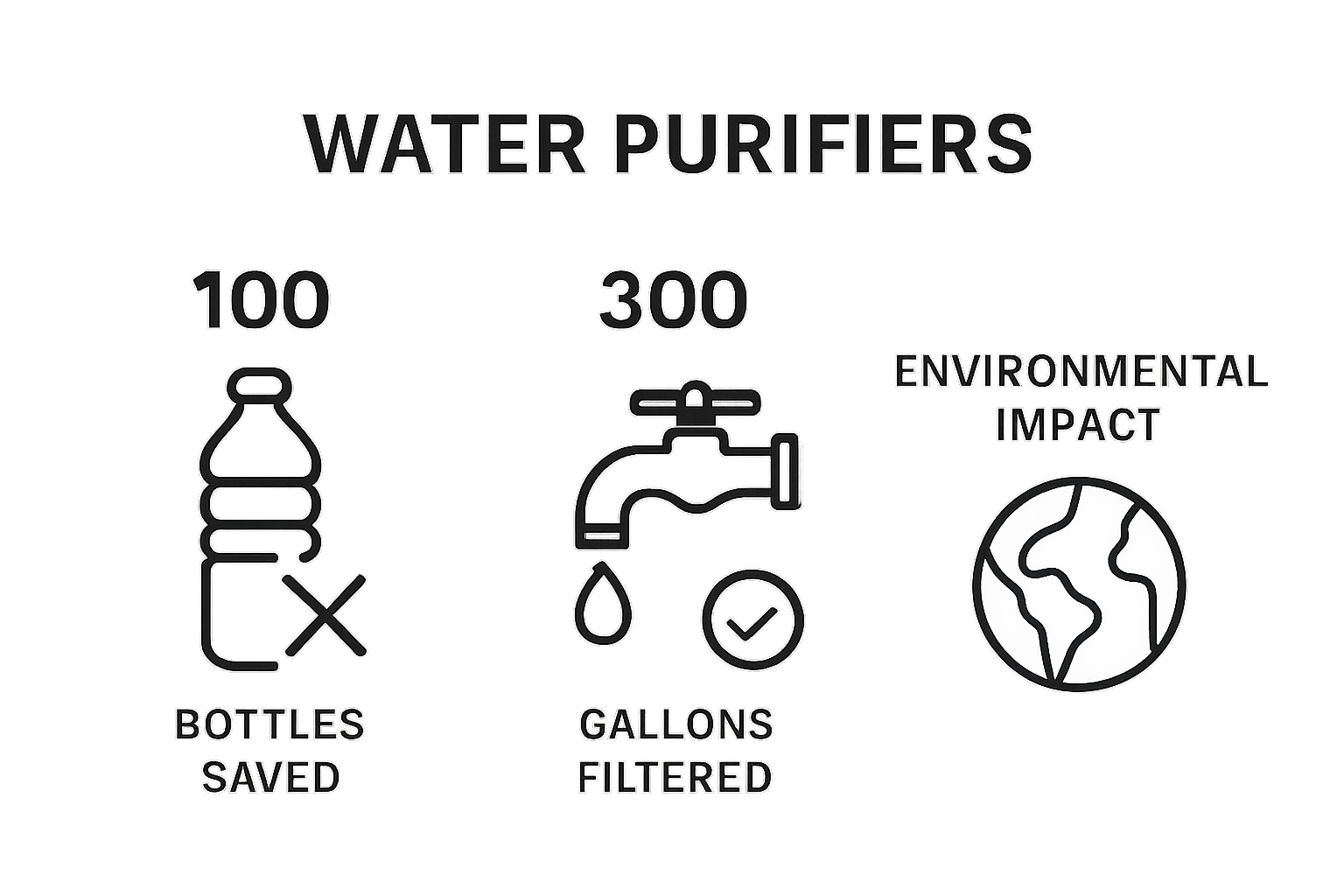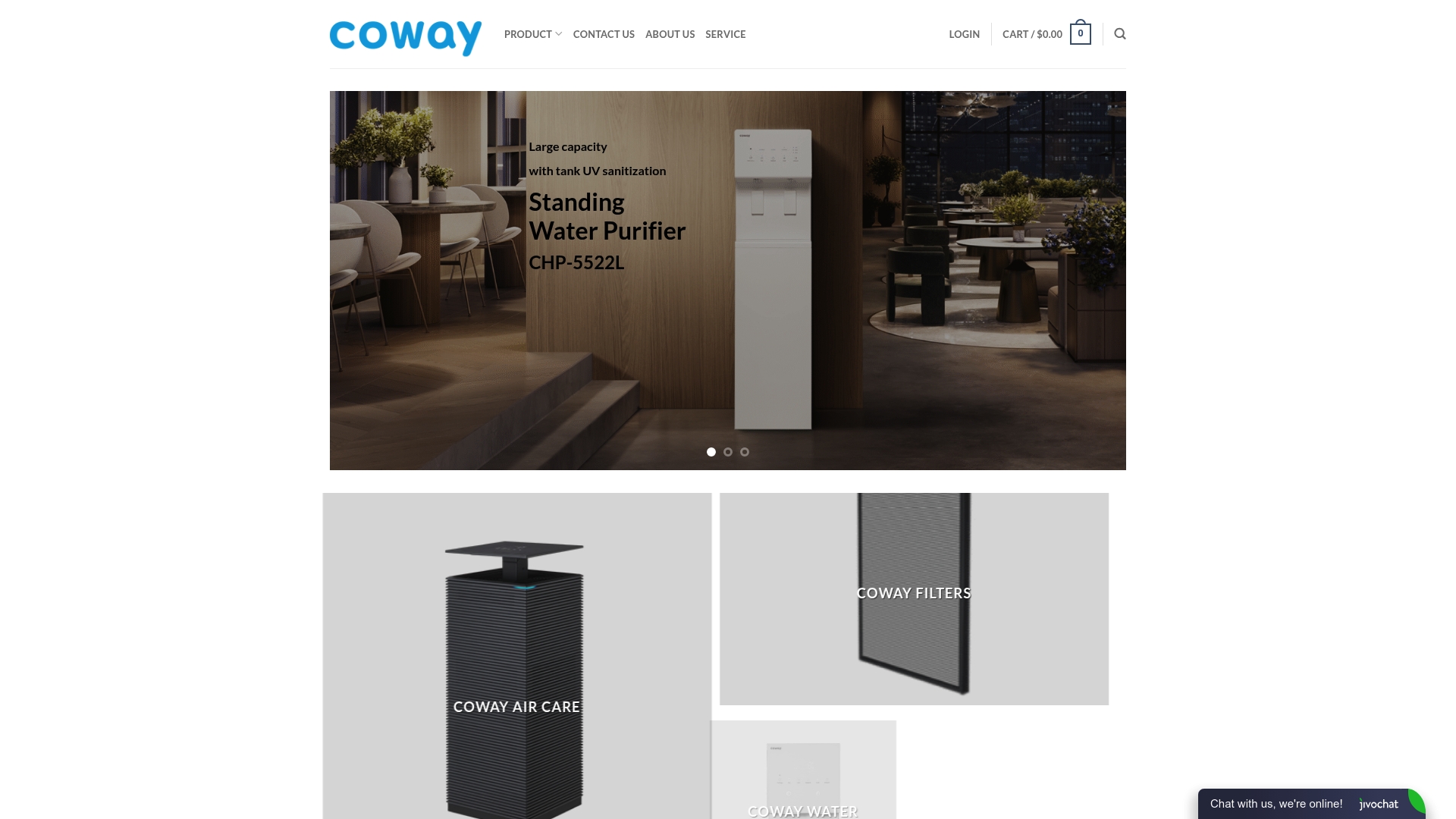Uncategorized
Why Invest in Water Purifiers: Understanding Benefits
Everyone knows tap water travels a long way before reaching your glass, picking up invisible threats along the journey. Surprising, but only around 9 percent of plastic bottles ever get recycled while the rest clog landfills and pollute oceans. Choosing a water purifier does more than clean your drinking water. It quietly protects your health and saves the planet at the same time.
Table of Contents
- What Are Water Purifiers And How Do They Function?
- The Importance Of Clean Water For Health And Wellness
- Understanding Contaminants: Why Filter Your Water?
- Long-Term Savings: Cost-Effectiveness Of Investing In Water Purifiers
- Environmental Impact: Reducing Plastic Waste With Water Purifiers
Quick Summary
| Takeaway | Explanation |
|---|---|
| Invest in water purifiers for health | Water purifiers remove harmful contaminants, ensuring access to clean drinking water for better health outcomes. |
| Understand water contaminants’ health risks | Contaminated water can cause serious health issues, from gastrointestinal infections to long-term developmental challenges in children. |
| Reduce plastic waste with filtration | Utilizing water purifiers decreases the reliance on bottled water, significantly cutting down on plastic waste and environmental impact. |
| Consider long-term savings on water | A home water purification system is a one-time investment that can reduce expenses from bottled water and healthcare related to waterborne illnesses. |
| Evaluate multiple filtration technologies | Different filtration methods, like reverse osmosis and UV sanitization, work together in purifiers to provide comprehensive water treatment. |
What Are Water Purifiers and How Do They Function?
Water purifiers are sophisticated filtration systems designed to remove contaminants, impurities, and potentially harmful substances from drinking water, transforming ordinary tap water into safe, clean, and high-quality drinking water. These advanced devices go beyond simple filtration, employing multiple technologies to ensure water meets stringent health and safety standards.
The Science Behind Water Purification
At their core, water purifiers operate through a complex multi-stage filtration process that targets different types of contaminants. The primary objective is comprehensive water treatment, which involves removing physical, chemical, and biological impurities. According to Environmental Protection Agency, effective water purification typically involves several key stages:
- Sediment filtration to remove larger particles
- Activated carbon filtration to eliminate chlorine and organic compounds
- Reverse osmosis membrane for removing microscopic contaminants
- UV sanitization to neutralize bacteria and viruses
Types of Filtration Technologies
Modern water purifiers integrate various filtration technologies to provide comprehensive water treatment. Different systems might utilize:
- Mechanical Filters: Use physical barriers to trap sediments and particles
- Chemical Filters: Neutralize chemical contaminants through absorption
- Biological Filters: Eliminate microorganisms and potential pathogens
- Activated Carbon Filters: Reduce chlorine, improve taste, and remove organic compounds
Understanding why invest in water purifiers becomes clear when you recognize the critical role these systems play in protecting household health. By removing potentially dangerous contaminants, water purifiers provide a reliable solution for accessing clean, safe drinking water directly from your tap.
To help clarify the main differences between water filtration technologies mentioned in the article, the following table compares their primary functions and benefits.
| Filtration Technology | Main Function | Key Benefits |
|---|---|---|
| Mechanical Filter | Traps larger particles and sediments | Removes visible impurities, protects other filters |
| Activated Carbon Filter | Adsorbs chlorine and organic compounds | Improves taste and odor, reduces chemicals |
| Reverse Osmosis (RO) | Forces water through a semi-permeable membrane | Removes dissolved solids and microscopic contaminants |
| UV Sanitization | Uses ultraviolet light to deactivate microbes | Neutralizes bacteria and viruses |
| Chemical Filter | Neutralizes chemical contaminants | Reduces pesticides, industrial pollutants |
| Biological Filter | Eliminates microorganisms | Provides extra pathogen protection |
The Importance of Clean Water for Health and Wellness
Clean water represents far more than a basic necessity it is a fundamental cornerstone of human health and wellness. What many people do not realize is that water quality directly impacts physiological functions, immune system performance, and long term health outcomes. Consuming contaminated water exposes individuals to significant health risks that can range from immediate digestive issues to chronic medical conditions.
Hidden Health Risks of Contaminated Water
Contaminated water sources can harbor a wide array of dangerous microorganisms and chemical pollutants that compromise human health.
According to research from the National Institutes of Health, water-related health risks include:
- Gastrointestinal infections and severe digestive disorders
- Neurological complications from heavy metal exposure
- Compromised immune system functioning
- Potential long-term developmental challenges in children
- Increased susceptibility to waterborne diseases
Biological Impact of Water Quality
The human body relies on water for critical metabolic processes, cellular hydration, and toxin elimination. Pure water supports optimal physiological functioning by enabling efficient nutrient transportation, maintaining cellular integrity, and supporting complex biochemical reactions. When water contains contaminants, these essential processes become disrupted, potentially leading to subtle yet significant health complications.
Consuming clean water is not just about avoiding immediate illness it represents a proactive approach to maintaining comprehensive wellness. By understanding the profound connection between water quality and human health, individuals can make informed decisions about their water consumption and invest in robust water purification solutions that protect their well-being.
Understanding Contaminants: Why Filter Your Water?
Understanding water contaminants is crucial for protecting personal health and ensuring safe drinking water. Water sources can contain numerous invisible threats that compromise human wellness, making water filtration an essential protective measure for households and individuals.
Common Water Contaminants and Their Sources
According to the Environmental Working Group, water contamination originates from diverse sources including industrial processes, agricultural runoff, natural geological formations, and aging infrastructure. The most prevalent dangerous contaminants include:
- Heavy Metals: Lead, mercury, arsenic
- Chemical Pollutants: Pesticides, industrial solvents
- Biological Agents: Bacteria, viruses, parasites
- Synthetic Compounds: Pharmaceutical residues, microplastics
Health Implications of Unfiltered Water
Contaminants present significant health risks that extend far beyond immediate digestive issues. Prolonged exposure to contaminated water can lead to serious long-term health complications, including neurological disorders, reproductive problems, and increased cancer risks. Vulnerable populations such as children, elderly, and individuals with compromised immune systems face even greater potential health threats from untreated water.
The following table summarizes common water contaminants found in household water supplies, their sources, and the potential health risks they pose, as outlined in the article.
| Contaminant Type | Examples | Typical Sources | Potential Health Risks |
|---|---|---|---|
| Heavy Metals | Lead, mercury, arsenic | Aging pipes, natural deposits | Neurological issues, developmental problems |
| Chemical Pollutants | Pesticides, solvents | Agricultural runoff, industry | Hormonal disruption, increased cancer risk |
| Biological Agents | Bacteria, viruses, parasites | Contaminated water sources | Gastrointestinal illness, waterborne disease |
| Synthetic Compounds | Pharmaceutical residues, microplastics | Improper disposal, plastic pollution | Potential immune and organ disruption |
By investing in comprehensive water purification systems, individuals take a proactive step toward protecting their health, neutralizing potential contaminants, and ensuring access to clean, safe drinking water. Water filtration is not just a luxury but a critical component of maintaining personal and family wellness in an increasingly complex environmental landscape.
Long-Term Savings: Cost-Effectiveness of Investing in Water Purifiers
Investing in water purifiers represents a strategic financial decision that extends far beyond initial purchase costs. While many consumers view water purification systems as an expense, they are actually a sophisticated long-term investment in health, wellness, and economic efficiency.
Direct and Indirect Financial Benefits
According to Environmental Protection Agency economic analyses, water purification investments yield significant financial advantages through multiple channels. The true cost-effectiveness of water purifiers emerges through several key financial dimensions:
- Reduction in bottled water purchases
- Decreased healthcare expenses from waterborne illness prevention
- Extended lifespan of household appliances by reducing mineral buildup
- Lower maintenance costs for plumbing systems
- Potential increase in property value
Comparative Economic Analysis
Traditional approaches to water consumption involve recurring expenses that often go unnoticed. Purchasing bottled water or relying on single-use filtration solutions can accumulate substantial costs over time. A typical household might spend hundreds of dollars annually on bottled water, whereas a comprehensive water purification system represents a one-time investment with minimal ongoing maintenance expenses.
By choosing a high-quality water purifier, consumers transform a potential recurring expense into a strategic long-term investment. The system not only provides clean, safe drinking water but also delivers consistent financial benefits through reduced health risks, lower consumable water expenses, and protection of household infrastructure.
 Viewing water purification as an economic strategy rather than a simple household purchase demonstrates a sophisticated approach to personal and family wellness.
Viewing water purification as an economic strategy rather than a simple household purchase demonstrates a sophisticated approach to personal and family wellness.
Environmental Impact: Reducing Plastic Waste with Water Purifiers
Water purifiers represent a powerful solution to the growing environmental crisis of single-use plastic waste. By providing clean, safe drinking water directly from household taps, these systems offer a sustainable alternative to bottled water consumption that significantly reduces plastic pollution and environmental degradation.
The Plastic Waste Challenge
Contemporary consumer habits generate massive plastic waste volumes, with bottled water being a substantial contributor. According to the Environmental Protection Agency, adopting sustainable water consumption practices can dramatically reduce environmental impact. Key environmental consequences of bottled water consumption include:
- Approximately 1 million plastic bottles purchased every minute globally
- Less than 9% of plastic bottles successfully recycled
- Significant carbon emissions from plastic production and transportation
- Extensive landfill accumulation and marine ecosystem contamination
Sustainable Water Consumption Strategies
Water purifiers provide a comprehensive approach to reducing plastic waste by eliminating the need for single-use bottled water. By installing home filtration systems, individuals can:
- Produce unlimited clean water without generating plastic waste
- Reduce carbon footprint associated with bottled water production
- Save money through sustainable home water treatment
- Minimize environmental pollution from plastic manufacturing
Choosing water purifiers represents more than a personal health decision it is a meaningful commitment to environmental conservation.
This table highlights the environmental challenges posed by bottled water, contrasting them with the sustainability benefits gained by investing in home water purification, as described in the article.
| Aspect | Bottled Water | Home Water Purifier Systems |
|---|---|---|
| Plastic Waste Generated | High (millions of bottles wasted) | Negligible |
| Recycling Rate | Less than 9% | Not applicable |
| Carbon Footprint | High (production & transportation) | Low |
| Cost Over Time | Recurring (monthly/annual) | One-time, with minimal maintenance |
| Impact on Landfills/Oceans | Major contributor | Minimal |
 Each household that transitions to home water filtration contributes to a broader movement of sustainable consumption, helping mitigate the global plastic waste crisis and protecting natural ecosystems for future generations.
Each household that transitions to home water filtration contributes to a broader movement of sustainable consumption, helping mitigate the global plastic waste crisis and protecting natural ecosystems for future generations.
Experience the Real Benefits of Water Purifiers with Coway
You have read how unfiltered water can quietly impact health, cause unexpected costs, and add to plastic waste. The uncertainties about water safety affect your family’s well-being every single day. The article explained the dangers of contaminants like heavy metals and bacteria, the long-term cost of bottled water, and the crucial role of quality water in daily life. Why not protect your loved ones and your budget with proven water purification dedicated to your needs?

Make the move toward a safer, healthier home right now. Explore the advanced models and scientific filtration options at Coway Water Purifiers. See for yourself how countertop and under-sink units with UV sanitization deliver truly clean water straight from your tap. Every Coway system is backed by professional installation and comprehensive care. Visit our product page to learn more and secure reliable water purification before the next health concern or expense arises. Give your family the security of clean water now.
Frequently Asked Questions
What are the main benefits of investing in a water purifier?
Investing in a water purifier provides numerous benefits, including access to clean, safe drinking water, improved health by reducing contaminants, financial savings on bottled water, and a positive environmental impact by minimizing plastic waste.
How do water purifiers work to eliminate contaminants?
Water purifiers work through multi-stage filtration processes that include sediment filtration, activated carbon filtration, reverse osmosis, and UV sanitization to effectively remove physical, chemical, and biological impurities from drinking water.
What types of contaminants can water purifiers remove?
Water purifiers can remove a variety of contaminants, including heavy metals like lead and mercury, chemical pollutants such as pesticides and industrial solvents, biological agents like bacteria and viruses, and synthetic compounds, including pharmaceutical residues and microplastics.
How do water purifiers contribute to environmental sustainability?
Water purifiers help reduce environmental impact by eliminating the need for single-use plastic bottles, thereby decreasing plastic waste and pollution. By using a water purifier, households can significantly lower their carbon footprint associated with bottled water production and divert plastic from landfills and marine ecosystems.

